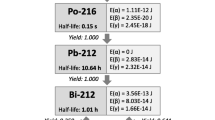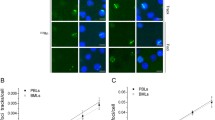Abstract
Gamma-H2AX (γ-H2AX) assay is a marker to measure double-strand breaks in the deoxyribonucleic acid. Variables such as age, oxidative stress, temperature, genetic factors and inter-individual variation have been reported to influence the baseline γ-H2AX focus levels. Therefore, knowledge on baseline frequency of γ-H2AX foci in a targeted population would facilitate reliable radiation triage and dose estimation. The objective of the present study was to establish the baseline data using blood samples from healthy volunteers (n = 130) differing in age, occupation and lifestyle as well as from occupationally exposed health workers (n = 20). The γ-H2AX focus assay was performed using epifluorescence microscopy. In vitro dose–response curve for γ-H2AX foci was constructed in blood samples (n = 3) exposed to X-rays (30 min post-exposure). The mean γ-H2AX focus frequency obtained in healthy volunteers was 0.042 ± 0.001 and showed an age-related increase (p < 0.001). Significantly higher (p < 0.005) focus frequencies were observed in health workers (0.066 ± 0.005) than in healthy volunteers. A sub-group analysis did not show a significant (p > 0.1) difference in γ-H2AX focus frequency among sexes. Blood exposed in vitro to X-rays showed dose-dependent increase in γ-H2AX foci frequency (Y = 0.1902 ± 0.1363 + 2.9020 ± 0.3240 * D). Baseline frequency of γ-H2AX foci obtained from different age groups showed a significant (p < 0.01) influence on the dose–response coefficients. The overall results demonstrated that the γ-H2AX assay can be used as a reliable biomarker for radiation triage and estimating the radiation absorbed dose by considering variables such as age, occupation and lifestyle factors.



Similar content being viewed by others
References
Ainsbury EA, Lloyd DC (2010) Dose estimation software for radiation biodosimetry. Health Phys 98(2):290–295
Ainsbury EA, Bakhanova E, Barquinero JF, Brai M, Chumak V, Correcher V, Darroudi F, Fattibene P, Gruel G, Guclu I, Horn S, Jaworska A, Kulka U, Lindholm C, Lloyd D, Longo A, Marrale M, Gil OM, Oestreicher U, Pajic J, Rakic B, Romm H, Trompier F, Veronese I, Voisin P, Vral A, Whitehouse CA, Wieser A, Woda C, Wojcik A, Rothkamm K (2011) Review of retrospective dosimetry techniques for external ionising radiation exposures. Radiat Prot Dosim 147(4):573–592
Barber PR, Locke RJ, Pierce GP, Rothkamm K, Vojnovic B (2007) Gamma-H2AX foci counting: image processing and control software for high-content screening. Proc SPIE 6441:64411M. doi:10.1117/12.705217
Barnard S, Ainsbury EA, Al-hafidh J, Hadjidekova V, Hristova R, Lindholm C, Gil OM, Moquet J, Moreno M, Rossler U, Thierens H, Vandevoorde C, Vral A, Wojewodzka M, Rothkamm K (2015) The first gamma-H2AX biodosimetry intercomparison exercise of the developing European biodosimetry network RENEB. Radiat Prot Dosim 164(3):265–270
Beels L, Bacher K, De Wolf D, Werbrouck J, Thierens H (2009) γ-H2AX foci as a biomarker for patient X-ray exposure in pediatric cardiac catheterization are we underestimating radiation risks? Circulation 120(19):1903–1909
Bhavani M, Selvan GT, Kaur H, Adhikari JS, Vijayalakshmi J, Venkatachalam P, Chaudhury NK (2014) Dicentric chromosome aberration analysis using giemsa and centromere specific fluorescence in situ hybridization for biological dosimetry: an inter- and intra-laboratory comparison in Indian laboratories. Appl Radiat Isot 92C:85–90
Fenech M (1998) Important variables that influence base-line micronucleus frequency in cytokinesis-blocked lymphocytes-a biomarker for DNA damage in human populations. Mutat Res 404(1–2):155–165
Fenech M, Morley AA (1985) Measurement of micronuclei in lymphocytes. Mutat Res 147(1–2):29–36
Greenstock CL, Trivedi A (1994) Biological and biophysical techniques to assess radiation exposure: a perspective. Prog Biophys Mol Biol 61(2):81–130
Horn S, Barnard S, Rothkamm K (2011) Gamma-H2AX-based dose estimation for whole and partial body radiation exposure. PLoS One 6(9):e25113
International Atomic Energy Agency (2011) Cytogenetic dosimetry: applications in preparedness for and response to radiation emergencies. IAEA, Vienna
Ishida M, Ishida T, Tashiro S, Uchida H, Sakai C, Hironobe N, Miura K, Hashimoto Y, Arihiro K, Chayama K, Kihara Y, Yoshizumi M (2014) Smoking cessation reverses DNA double-strand breaks in human mononuclear cells. PLoS One 9(8):e103993
Ismail IH, Wadhra TI, Hammarsten O (2007) An optimized method for detecting gamma-H2AX in blood cells reveals a significant interindividual variation in the gamma-H2AX response among humans. Nucleic Acids Res 35(5):e36
Kaneko H, Igarashi K, Kataoka K, Miura M (2005) Heat shock induces phosphorylation of histone H2AX in mammalian cells. Biochem Biophys Res Commun 328(4):1101–1106
Kuefner MA, Grudzenski S, Schwab SA, Wiederseiner M, Heckmann M, Bautz W, Lobrich M, Uder M (2009) DNA double-strand breaks and their repair in blood lymphocytes of patients undergoing angiographic procedures. Investig Radiol 44(8):440–446
Li Z, Yang J, Huang H (2006) Oxidative stress induces H2AX phosphorylation in human spermatozoa. FEBS Lett 580(26):6161–6168
Lloyd DC (1997) Chromosomal analysis to assess radiation dose. Stem Cells 15(Suppl 2):195–201. doi:10.1002/stem.5530150727
Löbrich M, Rief N, Kühne M, Heckmann M, Fleckenstein J, Rübe C, Uder M (2005) In vivo formation and repair of DNA double-strand breaks after computed tomography examinations. Proc Natl Acad Sci USA 102(25):8984–8989
Lucas JN, Awa A, Straume T, Poggensee M, Kodama Y, Nakano M, Ohtaki K, Weier HU, Pinkel D, Gray J et al (1992) Rapid translocation frequency analysis in humans decades after exposure to ionizing radiation. Int J Radiat Biol 62(1):53–63
Mah L-J, El-Osta A, Karagiannis TC (2010) γH2AX as a molecular marker of aging and disease. Epigenetics 5(2):129–136
Moquet J, Barnard S, Rothkamm K (2014) Gamma-H2AX biodosimetry for use in large scale radiation incidents: comparison of a rapid ‘96 well lyse/fix’ protocol with a routine method. PeerJ 2:e282
Mumbrekar KD, Fernandes DJ, Goutham HV, Sharan K, Vadhiraja BM, Satyamoorthy K, Sadashiva SRB (2014) Influence of double-strand break repair on radiation therapy-induced acute skin reactions in breast cancer patients. Int J Radiat Oncol Biol Phys 88(3):671–676
Qvarnström OF, Simonsson M, Johansson K-A, Nyman J, Turesson I (2004) DNA double strand break quantification in skin biopsies. Radiother Oncol 72(3):311–317
Ramsey MJ, Moore DH II, Briner JF, Lee DA, Olsen LA, Sneft JR, Tucker JD (1995) The effects of age and lifestyle factors on the accumulation of cytogenetic damage as measured by chromosome painting. Mutat Res 338:95–106
Redon CE, Dickey JS, Bonner WM, Sedelnikova OA (2009) gamma-H2AX as a biomarker of DNA damage induced by ionizing radiation in human peripheral blood lymphocytes and artificial skin. Adv Space Res 43(8):1171–1178
Redon CE, Nakamura AJ, Gouliaeva K, Rahman A, Blakely WF, Bonner WM (2010) The use of gamma-H2AX as a biodosimeter for total-body radiation exposure in non-human primates. PLoS One 5(11):e15544
Reisz JA, Bansal N, Qian J, Zhao W, Furdui C (2014) Effects of ionizing radiation on biological molecules—mechanisms of damage and emerging methods of detection. Antioxid Redox Signal 21(2):260–292
Roch-Lefevre S, Mandina T, Voisin P, Gaetan G, Mesa JE, Valente M, Bonnesoeur P, Garcia O, Roy L (2010) Quantification of gamma-H2AX foci in human lymphocytes: a method for biological dosimetry after ionizing radiation exposure. Radiat Res 174(2):185–194
Rogakou EP, Boon C, Redon C, Bonner WM (1999) Megabase chromatin domains involved in DNA double-strand breaks in vivo. J Cell Biol 146(5):905–916
Rothkamm K, Krüger I, Thompson LH, Löbrich M (2003) Pathways of DNA double-strand break repair during the mammalian cell cycle. Mol Cell Biol 23(16):5706–5715
Rothkamm K, Barnard S, Ainsbury EA, Al-Hafidh J, Barquinero JF, Lindholm C, Moquet J, Perala M, Roch-Lefevre S, Scherthan H, Thierens H, Vral A, Vandersickel V (2013a) Manual versus automated gamma-H2AX foci analysis across five European laboratories: can this assay be used for rapid biodosimetry in a large scale radiation accident? Mutat Res 756(1–2):170–173
Rothkamm K, Horn S, Scherthan H, Rößler U, De Amicis A, Barnard S, Kulka U, Lista F, Meineke V, Braselmann H (2013b) Laboratory intercomparison on the γ-H2AX foci assay. Radiat Res 180(2):149–155
Sak A, Grehl S, Erichsen P, Engelhard M, Grannaß A, Levegrün S, Pöttgen C, Groneberg M, Stuschke M (2007) gamma-H2AX foci formation in peripheral blood lymphocytes of tumor patients after local radiotherapy to different sites of the body: dependence on the dose-distribution, irradiated site and time from start of treatment. Int J Radiat Biol 83(10):639–652
Schurman SH, Dunn CA, Greaves R, Yu B, Ferrucci L, Croteau DL, Seidman MM, Bohr VA (2012) Age-related disease association of endogenous gamma-H2AX foci in mononuclear cells derived from leukapheresis. PLoS One 7(9):e45728
Sedelnikova OA, Horikawa I, Zimonjic DB, Popescu NC, Bonner WM, Barrett JC (2004) Senescing human cells and ageing mice accumulate DNA lesions with unrepairable double-strand breaks. Nat Cell Biol 6(2):168–170
Sedelnikova OA, Horikawa I, Redon C, Nakamura A, Zimonjic DB, Popescu NC, Bonner WM (2008) Delayed kinetics of DNA double-strand break processing in normal and pathological aging. Aging Cell 7(1):89–100
Sharma PM, Ponnaiya B, Taveras M, Shuryak I, Turner H, Brenner DJ (2015) High throughput measurement of gammaH2AX DSB repair kinetics in a healthy human population. PLoS One 10(3):e0121083
Stiff T, O’Driscoll M, Rief N, Iwabuchi K, Lobrich M, Jeggo PA (2004) ATM and DNA-PK function redundantly to phosphorylate H2AX after exposure to ionizing radiation. Cancer Res 64(7):2390–2396
Tamizh SG, Bhavani M, Vijayalakshmi J, Solomon FDP, Chaudhury N, Venkatachalam P (2014) Delayed mitogenic stimulation decreases DNA damage assessed by micronucleus assay in human peripheral blood lymphocytes after 60 CO irradiation. Dose-Response 12(3):498–508
Tanaka T, Halicka D, Traganos F, Darzynkiewicz Z (2009) Cytometric analysis of DNA damage: phosphorylation of histone H2AX as a marker of DNA double-strand breaks (DSBs). Methods Mol Biol 523:161–168
Turner HC, Sharma P, Perrier JR, Bertucci A, Smilenov L, Johnson G, Taveras M, Brenner DJ, Garty G (2014) The RABiT: high-throughput technology for assessing global DSB repair. Radiat Environ Biophys 53(2):265–272
Venkatachalam P, Paul S, Mohankumar M, Prabhu B, Gajendiran N, Jeevanram R (2000) Dose–response curve for translocation frequency with single pair of painted chromosome. A comparison with dicentric and micronuclei frequency. Radiat Prot Dosim 87(2):101–108
Venkateswarlu R, Tamizh SG, Bhavani M, Kumar A, Alok A, Karthik K, Kalra N, Vijayalakshmi J, Paul SF, Chaudhury NK, Venkatachalam P (2015) Mean frequency and relative fluorescence intensity measurement of gamma-H2AX foci dose response in PBL exposed to gamma-irradiation: an inter- and intra-laboratory comparison and its relevance for radiation triage. Cytom A 87(12):1138–1146
Vinnikov VA, Ainsbury EA, Maznyk NA, Lloyd DC, Rothkamm K (2010) Limitations associated with analysis of cytogenetic data for biological dosimetry. Radiat Res 174(4):403–414
Ward IM, Chen J (2001) Histone H2AX is phosphorylated in an ATR-dependent manner in response to replicational stress. J Biol Chem 276(51):47759–47762
Whitehouse CA, Edwards AA, Tawn EJ, Stephan G, Oestreicher U, Moquet JE, Lloyd DC, Roy L, Voisin P, Lindholm C, Barquinero J, Barrios L, Caballin MR, Darroudi F, Fomina J (2005) Translocation yields in peripheral blood lymphocytes from control populations. Int J Radiat Biol 81(2):139–145
Zakeri F, Assaei RG (2004) Cytogenetic monitoring of personnel working in angiocardiography laboratories in Iran hospitals. Mutat Res 562(1–2):1–9
Acknowledgments
We sincerely acknowledge Dr. P. Venkatesan, Deputy Director, Department of Biostatistics and Epidemiology, Tuberculosis Research Center (TRC), Indian Council of Medical Research (ICMR), for analysis and interpretation of the data. We thank Dr. Tripathi, Director, Institute of Nuclear Medicine and Allied Sciences (INMAS), Dr. Solomon F.D. Paul, Department of Human Genetics, for their support, and E Ainsbury, HPA, Centre for Radiation, Chemical and Environmental Hazards, Oxford, United Kingdom, for gifting us the ‘Dose Estimate’ software. We also thank Dr. Sebastian Spencer, Mitchell Cancer Institute, University of South Alabama, Mobile, USA, for the language correction.
Funding
This work was supported by from Life Science Research Board (LSRB), Defense Research Development Organization (DRDO), (DLS/81/48222/LSRB-261) and Department of Science and Technology (DST) (SR-SO/HS-127/2012).
Author information
Authors and Affiliations
Corresponding author
Ethics declarations
Conflict of interest
The authors declare that there is no conflict of interest.
Rights and permissions
About this article
Cite this article
Raavi, V., Basheerudeen, S.A.S., Jagannathan, V. et al. Frequency of gamma H2AX foci in healthy volunteers and health workers occupationally exposed to X-irradiation and its relevance in biological dosimetry. Radiat Environ Biophys 55, 339–347 (2016). https://doi.org/10.1007/s00411-016-0658-1
Received:
Accepted:
Published:
Issue Date:
DOI: https://doi.org/10.1007/s00411-016-0658-1




